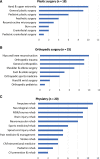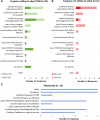Managing Neuroma and Phantom Limb Pain in Ontario: The Status of Targeted Muscle Reinnervation
- PMID: 33425599
- PMCID: PMC7787323
- DOI: 10.1097/GOX.0000000000003287
Managing Neuroma and Phantom Limb Pain in Ontario: The Status of Targeted Muscle Reinnervation
Abstract
Painful neuromas (PN) and phantom limb pain (PLP) are common following amputation and are unreliably treated, which impacts quality of life. Targeted muscle reinnervation (TMR) is a microsurgical technique that repairs the severed proximal nerve end to a redundant motor nerve in the amputated stump. Evidence supports TMR as effective in treating PN and PLP; however, its adoption has been slow. This study aimed to characterize: (1) the populations experiencing post-amputation PN/PLP; (2) current trends in managing PN/PLP; and (3) attitudes toward routine use of TMR to manage PN/PLP.
Methods: A cross-sectional survey was distributed to all orthopedic surgeons, plastic surgeons, and physiatrists practicing in Ontario, via publicly available emails and specialty associations. Data were collected on demographics, experience with amputation, managing post-amputation pain, and attitudes toward routine use of TMR.
Results: Sixty-six of 698 eligible participants submitted complete surveys (9.5% response rate). Respondents had a greater experience with surgical management of PN (71% PN versus 10% PLP). However, surgery was considered a 3rd-line option for PN and not an option for PLP in 57% and 59% of respondents, respectively. Thirty participants (45%) were unaware of TMR as an option, and only 8 respondents have currently incorporated TMR into their practice. Many (76%) would be willing to incorporate TMR into their practice as either an immediate or delayed surgical technique.
Conclusions: Despite its promise in managing post-amputation pain, awareness of TMR as a surgical option is generally poor. Several barriers to the widespread adoption of this technique are defined.
Copyright © 2020 The Authors. Published by Wolters Kluwer Health, Inc. on behalf of The American Society of Plastic Surgeons.
Conflict of interest statement
Figures








Similar articles
-
A consecutive series of targeted muscle reinnervation (TMR) cases for relief of neuroma and phantom limb pain: UK perspective.J Plast Reconstr Aesthet Surg. 2022 Mar;75(3):960-969. doi: 10.1016/j.bjps.2021.09.068. Epub 2021 Oct 22. J Plast Reconstr Aesthet Surg. 2022. PMID: 34840118
-
Targeted Muscle Reinnervation at the Time of Amputation Decreases Recurrent Symptomatic Neuroma Formation.Plast Reconstr Surg. 2024 Jan 1;153(1):154-163. doi: 10.1097/PRS.0000000000010692. Epub 2023 May 18. Plast Reconstr Surg. 2024. PMID: 37199690
-
Preemptive Treatment of Phantom and Residual Limb Pain with Targeted Muscle Reinnervation at the Time of Major Limb Amputation.J Am Coll Surg. 2019 Mar;228(3):217-226. doi: 10.1016/j.jamcollsurg.2018.12.015. Epub 2019 Jan 8. J Am Coll Surg. 2019. PMID: 30634038
-
Targeted muscle reinnervation: a brief history of a promising procedure for effective management of amputation pain.Wounds. 2023 Dec;35(12):E433-E438. doi: 10.25270/wnds/23079. Wounds. 2023. PMID: 38277632 Review.
-
Targeted Muscle Reinnervation to Reduce Postoperative Pain in Patients Undergoing Hindquarter Resections.Anticancer Res. 2023 Aug;43(8):3513-3516. doi: 10.21873/anticanres.16528. Anticancer Res. 2023. PMID: 37500121 Review.
Cited by
-
Trigeminal Traumatic Neuroma: a Comprehensive Review of the Literature Based On a Rare Case.Curr Pain Headache Rep. 2022 Mar;26(3):219-233. doi: 10.1007/s11916-022-01018-w. Epub 2022 Feb 4. Curr Pain Headache Rep. 2022. PMID: 35119601 Review.
-
Curative and preemptive treatment of amputee pain by targeted muscle reinnervation: experience from a French military trauma center.Eur J Trauma Emerg Surg. 2025 Jan 24;51(1):37. doi: 10.1007/s00068-024-02701-w. Eur J Trauma Emerg Surg. 2025. PMID: 39853391
References
-
- Ehde DM, Czerniecki JM, Smith DG, et al. Chronic phantom sensations, phantom pain, residual limb pain, and other regional pain after lower limb amputation. Arch Phys Med Rehabil. 2000;81:1039–1044. - PubMed
-
- Ephraim PL, Wegener ST, MacKenzie EJ, et al. Phantom pain, residual limb pain, and back pain in amputees: results of a national survey. Arch Phys Med Rehabil. 2005;86:1910–1919. - PubMed
-
- Kooijman CM, Dijkstra PU, Geertzen JHB, et al. Phantom pain and phantom sensations in upper limb amputees: an epidemiological study. Pain. 2000;87:33–41. - PubMed
-
- Golan JD, Jacques L. Nonneoplastic peripheral nerve tumors. Neurosurg Clin N Am. 2004;15:223–230. - PubMed
LinkOut - more resources
Full Text Sources
Research Materials
